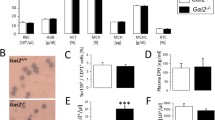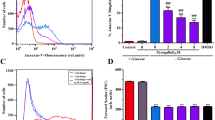Abstract
Eryptosis is a process by which mature erythrocytes can undergo self-destruction sharing several features with apoptosis. Premature programmed erythrocyte death may be induced by different agents. In this study, we compared mechanisms involved in two eryptotic models (oxidative stress and cell calcium overload) so as to distinguish whether they share signaling pathways and could be prevented by erythropoietin (Epo). Phosphatidylserine (PS) translocation and increased calcium content were common signs in erythrocytes exposed to sodium nitrite plus hydrogen peroxide or calcium ionophore A23187 (CaI), while increased ROS and decreased GSH levels were detected in the oxidative model. Protein kinase activation seemed to be an outstanding feature in eryptosis induced by oxidative stress, whereas phosphatase activation was favored in the CaI model. Cell morphology and membrane protein modifications were also differential signs between both models. Epo was able to prevent cell oxidative imbalance, thus blunting PS translocation. However, the hormone favored intracellular calcium influx which could be the reason why it could not completely counteract the induction of eryptosis. Instead, Epo was unable to inhibit PS externalization in the CaI model. The different mechanisms involved in the eryptotic models may explain the differential action of Epo upon erythrocytes induced to eryptosis by different agents.





Similar content being viewed by others
Abbreviations
- PMSF:
-
Phenylmethylsulfonyl fluoride
- SBTI:
-
Soybean trypsin inhibitor
- SDS:
-
Sodium dodecylsulfate
- NAC:
-
N-Acetyl-cysteine
- rhEpo:
-
Human recombinant erythropoietin
- PS:
-
Phosphatidylserine
- DCFH-DA:
-
2′,7′-Dichlorofluorescin diacetate
- PBS:
-
Phosphate-buffered saline
- ROS:
-
Reactive oxygen species
- GSH:
-
Reduced glutathione
- CaI:
-
Calcium ionophore A23187
- Hb:
-
Hemoglobin
- BSA:
-
Bovine serum albumin
- EMA:
-
Eosin-5-maleimide
- P-Tyr:
-
Phosphotyrosine residue
- N-Tyr:
-
Nitrotyrosine residue
- CI:
-
Calpain inhibitor I
- Aqp1:
-
Aquaporin 1
- EpoR:
-
Erythropoietin receptor
- PTP1B:
-
Phosphotyrosine phosphatase 1B
- p-NPP:
-
p-Nitrophenylphosphate
References
Bosman, G. J., Willekens, F. L., & Were, J. M. (2005). Erythrocyte aging: a more than superficial resemblance to apoptosis? Cellular Physiology and Biochemistry, 16, 1–8.
Daugas, E., Candé, C., & Kroemer, G. (2001). Erythrocytes: Death of a mummy. Cell Death and Differentiation, 8, 1131–1133.
Lang, K. S., Lang, P. A., Bauer, C., Duranton, C., Wiederm, T., Huber, S., et al. (2005). Mechanisms of suicidal erythrocyte death. Cellular Physiology and Biochemistry, 15, 195–202.
Lang, K. S., Myssina, S., Brand, V., Sandu, C., Lang, P. A., Berchtold, S., et al. (2004). Involvement of ceramide in hyperosmotic shock-induced death of erythrocytes. Cell Death and Differentiation, 11, 231–243.
Berg, C. P., Engels, I. H., Rothbart, A., Lauber, K., Renz, A., Schlosser, S. F., et al. (2001). Human mature red blood cells express caspase-3 and caspase-8, but are devoid of mitochondrial regulators of apoptosis. Cell Death and Differentiation, 8, 1197–1206.
Soupene, E., & Kuypers, F. A. (2006). Identification of an erythroid ATP-dependent aminophospholipid transporter. British Journal of Haematology, 133, 436–438.
Pietraforte, D., Matarrese, P., Straface, E., Gambardella, L., Metere, A., Scorza, G., et al. (2007). Two different pathways are involved in peroxynitrite-induced senescence and apoptosis of human erythrocytes. Free Radical Biology & Medicine, 42, 202–214.
Schwartz, A. B., Kahn, S. B., Kelch, B., Kim, K. E., & Pequignot, E. (1992). Red blood cell improved survival due to recombinant human erythropoietin explained effectiveness of less frequent, low dose subcutaneous therapy. Clinical Nephrology, 38, 283–289.
Polenakovic, M., & Sikole, A. (1996). Is erythropoietin a survival factor for red blood cells? Journal of American Society of Nephrology, 7, 1178–1182.
Chattopadhyay, A., Das Choudhury, T., Bandyopadhyay, D., & Datta, A. (2000). Protective effect of erythropoietin on the oxidative damage of erythrocyte membrane by hydroxyl radical. Biochemical Pharmacology, 59, 419–425.
Myssina, S., Huber, S. M., Birka, C., Lang, P. A., Lang, K. S., Friedrich, B., et al. (2003). Inhibition of erythrocyte cation channels by erythropoietin. Journal of American Society of Nephrology, 14, 2750–2757.
Bratosin, D., Estaquier, J., Petit, F., Arnoult, D., Quatannens, B., Tissier, J.-P., et al. (2001). Programmed cell death in mature erythrocytes: A model for investigating death effector pathways operating in the absence of mitochondria. Cell Death and Differentiation, 8, 1143–1156.
Vittori, D., Nesse, A., & Garbossa, G. (1999). Morphologic and functional alterations of erythroid cells induced by long term ingestion of aluminium. Journal of Inorganic Biochemistry, 76, 113–120.
Ghoti, H., Amer, J., Winder, A., Rachmilewitz, E., & Fibach, E. (2007). Oxidative stress in red blood cells, platelets and polymorphonuclear leukocytes from patients with myelodysplastic syndrome. European Journal of Haematology, 79, 463–467.
Callero, M., Pérez, G., Vittori, D., Pregi, N., & Nesse, A. (2007). Modulation of protein tyrosine phosphatase 1B by erythropoietin in UT-7 cell line. Cellular Physiology and Biochemistry, 20, 319–328.
Vittori, D., Garbossa, G., Lafourcade, C., Pérez, G., & Nesse, A. (2002). Human erythroid cells are affected by aluminium. Alteration of membrane band 3 protein. Biochimica Biophysica Acta (Biomembranes), 1558, 142–150.
Romero, P. J., & Romero, E. (1999). The role of calcium metabolism in human red blood cell ageing: a proposal. Blood Cells, Molecules, & Diseases, 25, 9–19.
Bevers, E. M., & Williamson, P. L. (2010). Phospholipid scramblase: An update. FEBS Letters, 584, 2724–2730.
Szabó, C., Ischiropoulos, H., & Radi, R. (2007). Peroxynitrite: Biochemistry, pathophysiology and development of therapeutics. Nature Reviews Drug Discovery, 6, 662–680.
Burak Çimen, M. Y. (2008). Free radical metabolism in human erythrocytes. Clinica Chimica Acta, 390, 1–11.
Palek, J., Stewart, G., & Lionetti, F. J. (1974). The dependence of shape of human erythrocyte ghosts on calcium, magnesium, and adenosine triphosphate. Blood, 44, 583–597.
Kirkpatrick, F. H., Hillman, D. G., & La Celle, P. L. (1975). A23187 and red cells: Changes in deformability, K+, Mg2+, Ca2+ and ATP. Experientia, 31, 653–654.
Daleke, D. L. (2008). Regulation of phospholipid asymmetry in the erythrocyte membrane. Current Opinion in Hematology, 15, 191–195.
Manno, S., Takakuwa, Y., & Mohandas, N. (2002). Identification of a functional role of lipid asymmetry in biological membranes: Phosphatidylserine–skeletal protein interactions modulate membrane stability. Proceedings of the National Academy of Sciences, 99, 1943–1948.
Wllekens, F. L. A., Were, J. M., Groenen-Dopp, Y. A. M., Roerdinkholder-Stoelwinder, B., de Pauw, B., & Bosman, G. J. C. (2008). Erythrocyte vesiculation: A self-protective mechanism? British Journal of Haematology, 141, 549–556.
Hagelberg, C., & Allan, D. (1990). Restricted diffusion of integral membrane proteins and polyphosphoinositides leads to their depletion in microvesicles released from human erythrocytes. Biochemical Journal, 271, 831–834.
Richards, R. S., Wang, L., & Jelinek, H. (2007). Erythrocyte oxidative damage in chronic fatigue syndrome. Archives of Medical Research, 38, 94–98.
Quintanar-Escorza, M. A., González-Martínez, M. T., Intriago-Ortega, M. P., & Calderón-Salinas, J. V. (2010). Oxidative damage increases intracellular free calcium [Ca2+] i concentration in human erythrocytes incubated with lead. Toxicology in Vitro, 24, 1338–1346.
Calderón-Salinas, J. V., Muñoz-Reyes, E. G., Guerrero-Romero, J. F., Rodríguez-Morán, M., Bracho-Riquelme, R. L., Carrera-Gracia, M. A., et al. (2011). Eryptosis and oxidative damage in type 2 diabetic mellitus patients with chronic kidney disease. Molecular and Cellular Biochemistry, 357, 171–179.
Mallozi, C., Di Stasi, A. M., & Minetti, M. (2001). Nitrotyrosine mimics phosphotyrosine binding to the SH2 domain of the src family tyrosine kinase lyn. FEBS Letters, 503, 189–195.
Chen, K., Piknova, B., Pittman, R. N., Schechter, A. N., & Popel, A. S. (2008). Nitric oxide from nitrite reduction by hemoglobin in the plasma and erythrocytes. Nitric Oxide, 18, 47–60.
Frangioni, J. V., Oda, A., Smith, M., Salzman, E. W., & Neel, B. G. (1993). Calpain-catalyzed cleavage and subcellular relocation of protein phosphotyrosine phosphatase 1B (PTP-1B) in human platelets. EMBO Journal, 12, 4843–4846.
Ciana, A., Minetti, G., & Balduini, C. (2004). Phosphotyrosine phosphatases acting on band 3 in human erythrocytes of different age: PTP1B processing during cell ageing. Bioelectrochemistry, 62, 169–173.
Metere, A., Iorio, E., Pietraforte, D., Podo, F., & Minetti, M. (2009). Peroxynitrite signaling in human erythrocytes: synergistic role of hemoglobin oxidation and band 3 tyrosine phosphorylation. Archives of Biochemistry and Biophysics, 484, 173–182.
Acknowledgments
This work was supported by grants from the University of Buenos Aires (UBA), the National Council of Scientific and Technical Research (CONICET) and the National Agency for Scientific and Technologic Promotion (ANPCYT). Dr. Alcira Nesse and Dr. Daniela Vittori are research scientists at the National Council of Scientific and Technical Research (CONICET), and Lic. Daiana Vota has received a fellowship from CONICET (Argentina).
Author information
Authors and Affiliations
Corresponding author
Rights and permissions
About this article
Cite this article
Vota, D.M., Maltaneri, R.E., Wenker, S.D. et al. Differential Erythropoietin Action upon Cells Induced to Eryptosis by Different Agents. Cell Biochem Biophys 65, 145–157 (2013). https://doi.org/10.1007/s12013-012-9408-4
Published:
Issue Date:
DOI: https://doi.org/10.1007/s12013-012-9408-4




